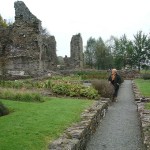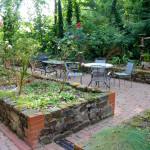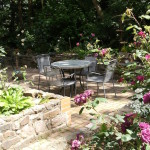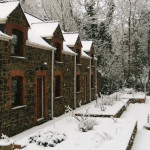The Monks Garden
After The Anchorage was built, the garden in front of the house proved very wet and muddy with a thick red clay soil. Roses, lavender and flowers put into the clay quickly died in the very acid wet soil. At the time archaeologists had been working on the then-overgrown ruins of the Elizabethan Priory in Haverfordwest. This also lies on flat muddy soil adjacent to the Western Cleddau River that passes through Haverfordwest. The archaeologists discovered that beneath the blackberry and heather jungle to one side of the ruins (Henry XIII again), there were some very well preserved Elizabethan gardens (the remains of another elaborate Elizabethan garden can be seen nearby in the ruins of Sir John Perrot’s house accessed from Merlin’s Bridge). The priory gardens character was that of raised stone boxes of soil with broad pathways between (see photograph). Some of the larger ones were probably used for vegetables, but the smaller ones were flower beds and have today been replanted. It seems that the abbot had his own private walled garden with its own gate. In addition to the earthly pleasure of drinking mead, the Elizabethan monks could also enjoy walks amongst the flower beds. Because these were raised in boxes, it was not necessary to bend over the flowers. So we are left with the image of portly short Celtic monks enjoying a walk and sniffing flowers in the raised beds.
After a visit to the excavated priory (open to the public and no charge), this seemed to be the ideal solution of what to do with the soggy front garden of The Anchorage. So we built our own Monks Garden which is now a pleasant patio, where visitors can eat their summer breakfast and enjoy a quiet evening BBQ under the tall trees surrounded by the raised flower beds. The plants are now happy and flourish in the same clay soil, which is now much drier in the raised stone boxes. Indeed one can now take a monks pleasure walk and sniff the tall flowers in our own Monks Garden (see photographs).
The excavated and conserve ruins of Haverfordwest Priory are open to the public all year round. Access is gained from Quay Street with public parking in the street. It was an Augustinian Priory founded around 1200 AD on land, alongside the Western Cleddau River, donated by Norman Lord Robert Fitztancard. It was dissolved by order of Henry VIII in 1536. The site was excavated between 1983 and 1996. The excavations revealed in addition to the chapel, a medieval ecclesiastical garden of raised beds. These have been conserved and replanted with plants appropriate to the time. It is the only ecclesiastical garden to survive in Britain.








